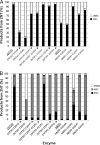Selection for growth on 3-nitrotoluene by 2-nitrotoluene-utilizing Acidovorax sp. strain JS42 identifies nitroarene dioxygenases with altered specificities
- PMID: 25344236
- PMCID: PMC4272708
- DOI: 10.1128/AEM.02772-14
Selection for growth on 3-nitrotoluene by 2-nitrotoluene-utilizing Acidovorax sp. strain JS42 identifies nitroarene dioxygenases with altered specificities
Abstract
Acidovorax sp. strain JS42 uses 2-nitrotoluene as a sole source of carbon and energy. The first enzyme of the degradation pathway, 2-nitrotoluene 2,3-dioxygenase, adds both atoms of molecular oxygen to 2-nitrotoluene, forming nitrite and 3-methylcatechol. All three mononitrotoluene isomers serve as substrates for 2-nitrotoluene dioxygenase, but strain JS42 is unable to grow on 3- or 4-nitrotoluene. Using both long- and short-term selections, we obtained spontaneous mutants of strain JS42 that grew on 3-nitrotoluene. All of the strains obtained by short-term selection had mutations in the gene encoding the α subunit of 2-nitrotoluene dioxygenase that changed isoleucine 204 at the active site to valine. Those strains obtained by long-term selections had mutations that changed the same residue to valine, alanine, or threonine or changed the alanine at position 405, which is just outside the active site, to glycine. All of these changes altered the regiospecificity of the enzymes with 3-nitrotoluene such that 4-methylcatechol was the primary product rather than 3-methylcatechol. Kinetic analyses indicated that the evolved enzymes had enhanced affinities for 3-nitrotoluene and were more catalytically efficient with 3-nitrotoluene than the wild-type enzyme. In contrast, the corresponding amino acid substitutions in the closely related enzyme nitrobenzene 1,2-dioxygenase were detrimental to enzyme activity. When cloned genes encoding the evolved dioxygenases were introduced into a JS42 mutant lacking a functional dioxygenase, the strains acquired the ability to grow on 3-nitrotoluene but with significantly longer doubling times than the evolved strains, suggesting that additional beneficial mutations occurred elsewhere in the genome.
Copyright © 2015, American Society for Microbiology. All Rights Reserved.
Figures


Similar articles
-
A Bph-Like Nitroarene Dioxygenase Catalyzes the Conversion of 3-Nitrotoluene to 3-Methylcatechol by Rhodococcus sp. Strain ZWL3NT.Appl Environ Microbiol. 2020 Feb 3;86(4):e02517-19. doi: 10.1128/AEM.02517-19. Print 2020 Feb 3. Appl Environ Microbiol. 2020. PMID: 31811044 Free PMC article.
-
Evolution of a new bacterial pathway for 4-nitrotoluene degradation.Mol Microbiol. 2011 Oct;82(2):355-64. doi: 10.1111/j.1365-2958.2011.07817.x. Epub 2011 Sep 13. Mol Microbiol. 2011. PMID: 21895789 Free PMC article.
-
Biodegradation of 2-nitrotoluene by Pseudomonas sp. strain JS42.Appl Environ Microbiol. 1994 Sep;60(9):3466-9. doi: 10.1128/aem.60.9.3466-3469.1994. Appl Environ Microbiol. 1994. PMID: 7944378 Free PMC article.
-
Active site residues controlling substrate specificity in 2-nitrotoluene dioxygenase from Acidovorax sp. strain JS42.J Ind Microbiol Biotechnol. 2005 Oct;32(10):465-73. doi: 10.1007/s10295-005-0021-z. Epub 2005 Oct 15. J Ind Microbiol Biotechnol. 2005. PMID: 16175409
-
Three types of taxis used in the response of Acidovorax sp. strain JS42 to 2-nitrotoluene.Appl Environ Microbiol. 2012 Apr;78(7):2306-15. doi: 10.1128/AEM.07183-11. Epub 2012 Jan 27. Appl Environ Microbiol. 2012. PMID: 22286989 Free PMC article.
Cited by
-
Environmental persistence, hazard, and mitigation challenges of nitroaromatic compounds.Environ Sci Pollut Res Int. 2019 Oct;26(28):28650-28667. doi: 10.1007/s11356-019-06043-8. Epub 2019 Aug 6. Environ Sci Pollut Res Int. 2019. PMID: 31388957
-
A Bph-Like Nitroarene Dioxygenase Catalyzes the Conversion of 3-Nitrotoluene to 3-Methylcatechol by Rhodococcus sp. Strain ZWL3NT.Appl Environ Microbiol. 2020 Feb 3;86(4):e02517-19. doi: 10.1128/AEM.02517-19. Print 2020 Feb 3. Appl Environ Microbiol. 2020. PMID: 31811044 Free PMC article.
-
Semi-rational design of nitroarene dioxygenase for catalytic ability toward 2,4-dichloronitrobenzene.Appl Environ Microbiol. 2024 Jun 18;90(6):e0143623. doi: 10.1128/aem.01436-23. Epub 2024 May 6. Appl Environ Microbiol. 2024. PMID: 38709097 Free PMC article.
-
Evolution of Rhodopseudomonas palustris to degrade halogenated aromatic compounds involves changes in pathway regulation and enzyme specificity.Appl Environ Microbiol. 2024 Feb 21;90(2):e0210423. doi: 10.1128/aem.02104-23. Epub 2024 Jan 11. Appl Environ Microbiol. 2024. PMID: 38206012 Free PMC article.
-
3,6-Dichlorosalicylate Catabolism Is Initiated by the DsmABC Cytochrome P450 Monooxygenase System in Rhizorhabdus dicambivorans Ndbn-20.Appl Environ Microbiol. 2018 Jan 31;84(4):e02133-17. doi: 10.1128/AEM.02133-17. Print 2018 Feb 15. Appl Environ Microbiol. 2018. PMID: 29196293 Free PMC article.
References
-
- Hartter DR. 1985. The use and importance of nitroaromatic chemicals in the chemical industry, p 1–14. In Rickert DE. (ed), Toxicity of nitroaromatic compounds. Chemical Industry Institute of Toxicology series. Hemisphere, Washington, DC.
-
- Swoboda-Colberg NG. 1995. Chemical contamination of the environment: sources, types, and fate of synthetic organic chemicals, p 27–74. In Young LY, Cerniglia CE (ed), Microbial transformation and degradation of toxic organic chemicals. Wiley-Liss, New York, NY.
-
- Burmaster DE. 1982. The new pollution: groundwater contamination. Environment 24:6–13, 22–36.
-
- Callahan MA, Slimak MW, Gabel NW, May JP, Fowler CF, Freed JR, Jennings P, Durfee RL, Whitmore FC, Maestri B, Mabey WR, Holt BR, Gould C. 1979. Water-related environmental fate of 129 priority pollutants. EPA, Washington, DC.
Publication types
MeSH terms
Substances
Grants and funding
LinkOut - more resources
Full Text Sources
Other Literature Sources

